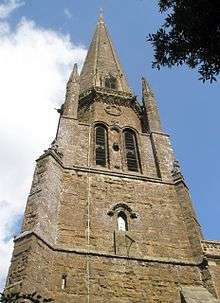St Mary's Church, Bloxham
| St Mary's Church, Bloxham | |
|---|---|
 The spire of St Mary's. | |
| 52°01′04″N 1°22′29″W / 52.0179°N 1.3747°WCoordinates: 52°01′04″N 1°22′29″W / 52.0179°N 1.3747°W | |
| Location | Bloxham |
| Country | England |
| Denomination | Church of England |
| History | |
| Dedication | St Mary |
| Architecture | |
| Heritage designation | Grade I listed |
| Architect(s) |
Original unknown Richard Winchcombe G.E. Street |
| Style | English Gothic |
| Administration | |
| Parish | Bloxham |
| Diocese | Diocese of Oxford |
| Province | Canterbury |
St Mary's Church, Bloxham is a Grade I listed Church of England parish church in Bloxham, Oxfordshire. It is notable for its 14th century tower and spire which is the highest in Oxfordshire. It is unusually large for a parish church and was described by the church historian, Sir Nikolaus Pevsner, as being "one of the grandest churches in the country."[1]
Building
The earliest church on the site was built in the late 12th century. Only fragments of the building from this period remain, including two doorways. The arcades date from the rebuilding of the original nave in the 13th century, but the present building was mainly constructed in the 14th and 15th centuries. The chancel and aisles were rebuilt in the early 14th century, as were the impressive north and south porches. During this time St Mary's was ornamented with a great deal of fine stonecarving, much of which survives. It is likely that this tracery was crafted by a school of masons who carried out similar work on the churches in Adderbury and Hanwell. The tower is thought to have been built between 1300 and 1340. Fragments of Mediaeval wall paintings survive inside St Mary's, including a Doom painting over the chancel arch and Saint Christopher over the north doorway. Remnants of 14th century stained glass survive in some of the windows.[2] The church's elaborate rood screen dates from the 15th century.
In the 15th century the Perpendicular Gothic Milcombe chapel (also known as the south chapel) was added.[3] Although the patron and architect are unknown, it is likely that the new building was designed by Richard Winchcombe.[3] The chapel contains a number of 18th century monuments to members of the local Thornycroft family and the tomb of Sir John Thornycroft, 1st Baronet.
In 1864–66 the eminent Gothic Revival architect G.E. Street carried out restoration work on St Mary's. As well as stabilising the spire, Street's work in the church includes the pulpit, choir stalls and reredos.[3] In 1868 Edward Burne-Jones created a stained glass window of St Christopher in the chancel and in 1869 William Morris, Edward Burne-Jones and Philip Webb created the east window.[4] The church tower has a ring of eight bells,[5] including one cast in about 1570 and a tenor bell cast in 1648.[6]
Patronage and use
In 1067 William the Conqueror granted St Mary's church and rectory estate to Westminster Abbey, meaning it indirectly under royal patronage. In the 12th century Henry II granted patronage of the church to Godstow Abbey, which led Westminster Abbey to complain to the Pope. However, the Papacy allowed Godstow to retain the church provided it made an annual payment to Westminster Abbey. With Henry VIII's dissolution of the monasteries in the 1530s Bloxham parish church returned to the patronage of the Crown, which granted it to Eton College in 1547.
The church is surrounded by a large graveyard, which has been expanded to the east several times. The church is regularly used by Bloxham School for its Founderstide and Christmas services. St Mary's benefice is now combined with those of Milcombe and South Newington, of which Bloxham is the principal church.[6]
References
- ↑ Sherwood & Pevsner 1974, pp. 477.
- ↑ Sherwood & Pevsner 1974, pp. 477–479.
- 1 2 3 Sherwood & Pevsner 1974, pp. 479.
- ↑ Sherwood & Pevsner 1974, pp. 478–480.
- ↑ "Bloxham". Diocese of Oxford for Oxford Diocesan Guild of Church Bell Ringers, Banbury Branch. Retrieved 24 August 2012.
- 1 2 Lobel & Crossley 1969, pp. 53–85.